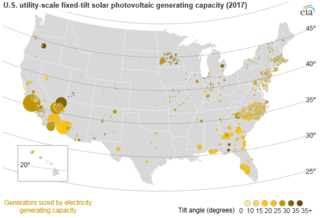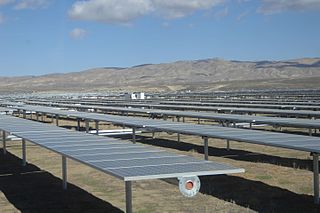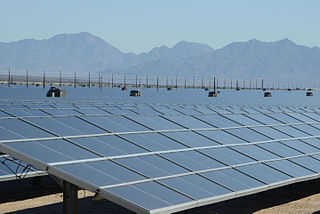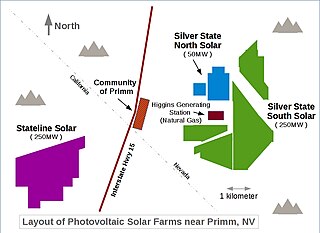
There are several solar power plants in the Mojave Desert which supply power to the electricity grid. Insolation in the Mojave Desert is among the best available in the United States, and some significant population centers are located in the area. These plants can generally be built in a few years because solar plants are built almost entirely with modular, readily available materials. Solar Energy Generating Systems (SEGS) is the name given to nine solar power plants in the Mojave Desert which were built in the 1980s, the first commercial solar plant. These plants have a combined capacity of 354 megawatts (MW) which made them the largest solar power installation in the world, until Ivanpah Solar Power Facility was finished in 2014.

Solar power in the United States includes utility-scale solar power plants as well as local distributed generation, mostly from rooftop photovoltaics. As of the end of 2019, the United States had over 71.3 gigawatts (GW) of installed photovoltaic capacity. In 2018, utility scale solar power generated 66.6 terawatt-hours (TWh), 1.66% of total U.S. electricity. During the same time period total solar generation, including estimated small scale photovoltaic generation, was 96.1 TWh, 2.30% of total U.S. electricity. In terms of total cumulative installed capacity, by year end 2017 the United States ranked 2nd in the world behind China. In 2016, 39% of all new electricity generation capacity in the country came from solar, more than any other source and ahead of natural gas (29%). By 2015, solar employment had overtaken oil and gas as well as coal employment in the United States. In 2016, more than 260,000 Americans were employed in the solar industry.

Topaz Solar Farm is a 550 megawatt (MWAC) photovoltaic power station in San Luis Obispo County, California. Construction on the project began in November 2011 and ended in November 2014. It is one of the world's largest solar farms. The $2.5 billion project includes 9 million CdTe photovoltaic modules based on thin-film technology, manufactured by U.S. company First Solar. The company also built, operates and maintains the project for MidAmerican Renewables, a Berkshire Hathaway company. Pacific Gas and Electric will buy the electricity under a 25-year power purchase agreement. According to First Solar, it created about 400 construction jobs.

The California Valley Solar Ranch (CVSR) is a 250 megawatt (MWAC) photovoltaic power plant in the Carrizo Plain, northeast of California Valley. The project is owned by NRG Energy, and SunPower is the EPC contractor and technology provider. The project constructed on 1,966 acres (796 ha) of a 4,365-acre (1,766 ha) site of former grazing land. It is utilizing high-efficiency, crystalline PV panels designed and manufactured by SunPower. The project includes up to 88,000 SunPower solar tracking devices to hold PV panels that track the sun across the sky.

Solar power in California includes utility-scale solar power plants as well as local distributed generation, mostly from rooftop photovoltaics. It has been growing rapidly because of high insolation, community support, declining solar costs, and a Renewable Portfolio Standard which requires that 33% of California's electricity come from renewable resources by 2020, and 60% by 2030. Much of this is expected to come from solar power via photovoltaic facilities or concentrated solar power facilities.

Solar power in Arizona has the potential to, according to then-Governor Janet Napolitano, make Arizona "the Persian Gulf of solar energy". In 2012, Arizona had 1,106 MW of photovoltaic (PV) solar power systems, and 6 MW of concentrated solar power (CSP), bringing the total to over 1,112 megawatts (MW) of solar power. The Solana Generating Station is a 280 MW parabolic trough solar plant which is the largest plant of its type in the world. Solana includes 6 hours of power storage by molten salt. The plant will provide 5% of the power from Arizona Public Service, the state's largest utility.
The Blythe Mesa Solar Power Project, also known as the Blythe Solar Energy Center, is a 235 megawatt (MWAC) photovoltaic power plant near the city of Blythe in Riverside County, California. It occupies about 2,000 acres of public land managed by the Bureau of Land Management in the Mojave Desert. The construction uses CdTe thin film panels from the U.S. firm First Solar, and the majority of the output is being sold to Kaiser Permanente and Southern California Edison under 20-year power purchase agreements.

The Desert Sunlight Solar Farm is a 550 megawatt (MWAC) photovoltaic power station approximately six miles north of Desert Center, California, in the Mojave Desert. It uses approximately 8.8 million cadmium telluride modules made by the US thin-film manufacturer First Solar. As of Fall 2015, the Solar Farm has the same 550 MW installed capacity as the Topaz Solar Farm in the Carrizo Plain region of Central California, making both of them tied for the second largest completed solar plants by installed capacity.
The Agua Caliente Solar Project is a 290 megawatt (MWAC) photovoltaic power station, built in Yuma County, Arizona using 5.2 million cadmium telluride modules made by the U.S. thin-film manufacturer First Solar. It was the largest solar facility in the world when the project was commissioned in April 2014.
The Centinela Solar Energy Project is a 170 megawatt (MW) photovoltaic power plant located on 2,067 acres (836 ha) of previously disturbed private land southwest of El Centro, California. The project planned to provide at least 235 jobs, generate more than $30 million in tax revenue over its life-time, and deliver enough electricity to power about 82,500 homes. Imperial County gave a green-light to the solar power plant on December 27, 2011, and Secretary of the Interior Ken Salazar approved the right-of-way over 19 acres for the connecting power line on public land.

The Czech Republic had almost two gigawatts (GW) of photovoltaic capacity at the end of 2010, but installed less than 10 megawatts (MW) in 2011 due to the feed-in tariff being reduced by 25%, after installing almost 1,500 MW the year before. Installations increased to 109 MW in 2012. In 2014, no new installations were reported.

Solar power in Mexico has the potential to produce vast amounts of energy. 70% of the country has an insolation of greater than 4.5 kWh/m2/day. Using 15% efficient photovoltaics, a square 25 km (16 mi) on each side in the state of Chihuahua or the Sonoran Desert could supply all of Mexico's electricity.

Solar power in South Africa includes photovoltaics (PV) as well as concentrated solar power (CSP). In 2016, South Africa had 1,329 MW of installed solar power capacity. Installed capacity is expected to reach 8,400 MW by 2030.
The Westlands Solar Park is a planned, large-scale solar power project in Kings County south of Fresno, California. It intends to build many photovoltaic power plants with a capacity totaling upwards of 2,000 megawatts (MW), larger than the world's largest photovoltaic power plants operating as of 2017. It will be constructed on brownfield land owned by the Westlands Water District that is unusable for agriculture due to excess salt pollution.
Campo Verde Solar Project is a 139-megawatt (MWAC) solar photovoltaic power station in Imperial County, California. The project was approved in December 2012. Construction began in early 2013 and was completed the same year. Designed and constructed by U.S. thin-film manufacturer First Solar, the plant uses nearly 2.3 million CdTe-PV modules. Campo Verde Solar was acquired in April 2013 by Southern Power and Turner Renewable Energy. First Solar acquired the project in 2012 from US Solar Holdings LLC, which had developed the project and negotiated the 139 MW PPA with SDG&E.
Mount Signal Solar, also known as Imperial Valley Solar Project, is a 594 MWp (460 MWAC) photovoltaic power station west of Calexico, California in the southern Imperial Valley, near the Mexican border. The facility is being developed and constructed by 8minutenergy Renewables in three phases, with two completed as of 2018. At full build-out, it will be one of the world's largest PV solar farms with a capacity of about 800 MWp (600 MWAC). The project has been supported by several environmental groups, as the power station was built on low productivity farmland.

Desert Stateline Solar Facility is a 300 MWp utility-scale solar photovoltaic power station constructed by First Solar in San Bernardino County California. It is located at the base of Clark Mountain in California, across the state line from Primm, Nevada and adjacent to the Ivanpah Solar Power Facility.
The Tenaska Imperial Solar Energy Center West is a 150 megawatt (MW) photovoltaic power plant built in Imperial County, California. Construction began in 2014 and full commercial operation was achieved in September 2016. Power is sold to San Diego Gas & Electric on a 25-year agreement.
The Beacon Solar Project is a photovoltaic power station in the northwestern Mojave Desert, near California City in eastern Kern County, California. Split into five phases, the Beacon solar facilities combined generate 250 MW of renewable energy for the Los Angeles Department of Water and Power (LADWP). The five projects, completed in December 2017 total 903,434 panels.












